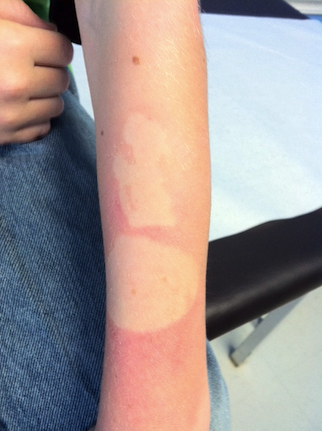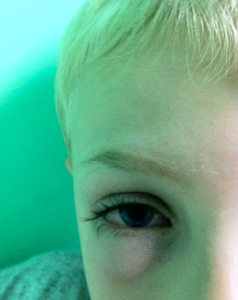 The antihistamine quandry
The antihistamine quandry
Junior’s nose is starting to twitch
His nose and his eyes are starting to itch.
As those boogies flow
You ask oh why, oh why can’t he learn to blow?
It’s nice to finally see the sun
But the influx of pollen is no fun.
Up at night, he’s had no rest,
But which antihistamine is the best?
It’s a riddle with a straight forward answer. The best antihistamine, or “allergy medicine” is the one which works best for your child with the fewest side effects. Overall, I don’t find much of a difference between how well one antihistamine works versus another for my patients. However, I do find a big difference in side effects.
Oral antihistamines differ mostly by how long they last, how well they help the itchiness and their side effect profile. During an allergic reaction, antihistamines block one of the agents responsible for producing swelling and secretions in your child’s body, called histamine.
Prescription antihistamines are not necessarily “stronger.” In fact, at this point there are very few prescription antihistamines. Most of what you see over-the-counter was by prescription only just a few years ago. And unlike some medications, the recommended dosage over-the-counter is the same as what we used to give when we wrote prescriptions for them.
The oldest category, the first generation antihistamines work well at drying up nasal secretions and stopping itchiness but don’t tend to last as long and often make kids very sleepy. Diphendydramine (brand name Benadryl) is the best known medicine in this category. It lasts only about six hours and can make people so tired that it is the main ingredient for many over-the-counter adult sleep aids. Occasionally, kids become “hyper” and are unable to sleep after taking this medicine. Other first generation antihistamines include Brompheniramine (eg. brand names Bromfed and Dimetapp) and Clemastine (eg.brand name Tavist).
The newer second generation antihistamines cause less sedation and are conveniently dosed only once a day. Loratadine (eg. brand name Alavert, Claritin) is biochemically more removed from diphenhydramine from than Cetirizine (eg. brand Zyrtec) and runs a slightly less risk of sleepiness. However, Cetirizine tends to be a better at stopping itchiness.
Now over-the-counter, fexofenadine (eg brand name Allegra) is a third generation antihistamine. Theoretically, because a third generation antihistamine is chemically the farthest removed from a first generation antihistamine, it causes the least amount of sedation. The jury is still out.
If you find your child’s allergies are breaking through oral antihistamines, discuss adding a different category of oral allergy medication, eye drops or nasal sprays with your pediatrician.
Because of decongestant side effects in children, avoid using an antihistamine and decongestant mix.
Back to our antihistamine poem:
Too many choices, some make kids tired,
While some, paradoxically, make them wired.
Maybe while watering flowers with a hose,
Just turn the nozzle onto his runny nose.
Naline Lai, MD with Julie Kardos, MD
©2011 Two Peds in a Pod®


 The antihistamine quandry
The antihistamine quandry  As spring break approaches, here are some ways to handle sickness while traveling with your children when you are far away from your children’s primary care provider.
As spring break approaches, here are some ways to handle sickness while traveling with your children when you are far away from your children’s primary care provider. Spring break has arrived for many college students. While students certainly deserve a vacation from the stress of school, parents should stay aware of their children’s spring break plans. Unfortunately, students who spend spring break with friends, rather than family, are much
Spring break has arrived for many college students. While students certainly deserve a vacation from the stress of school, parents should stay aware of their children’s spring break plans. Unfortunately, students who spend spring break with friends, rather than family, are much  I wish I had known the importance of vaccination for meningococcal disease before it was too late for my son. Back in September of 2004, David was a happy, healthy 13 year old, who came down with flu-like symptoms one evening. He first felt cold, then spiked a high fever, and vomited throughout the night. In the morning we called the pediatrician to have him seen. Everything ached, and he needed help getting dressed. That’s when I noticed purplish spots on his chest and arms. I didn’t know how serious that symptom was. As soon as the doctors saw him, they knew he had meningococcal disease. He was rushed to the ER for a spinal tap and treatment. Unfortunately, the disease spread quickly and his organs failed. David died within 24 hours of first developing those flu-like symptoms from a potentially vaccine-preventable disease. Unbelievable… and heartbreaking.
I wish I had known the importance of vaccination for meningococcal disease before it was too late for my son. Back in September of 2004, David was a happy, healthy 13 year old, who came down with flu-like symptoms one evening. He first felt cold, then spiked a high fever, and vomited throughout the night. In the morning we called the pediatrician to have him seen. Everything ached, and he needed help getting dressed. That’s when I noticed purplish spots on his chest and arms. I didn’t know how serious that symptom was. As soon as the doctors saw him, they knew he had meningococcal disease. He was rushed to the ER for a spinal tap and treatment. Unfortunately, the disease spread quickly and his organs failed. David died within 24 hours of first developing those flu-like symptoms from a potentially vaccine-preventable disease. Unbelievable… and heartbreaking.  Have a teenage couch potato from January through March? We all tend to decrease our activity level in the winter months. Physical Therapist Deb Stack gives us ideas to keep teens active.
Have a teenage couch potato from January through March? We all tend to decrease our activity level in the winter months. Physical Therapist Deb Stack gives us ideas to keep teens active.